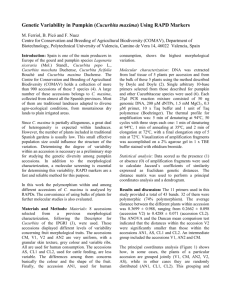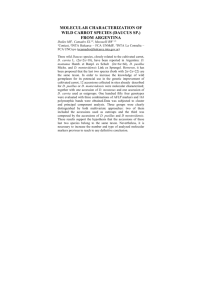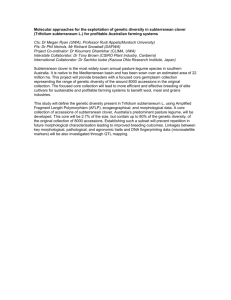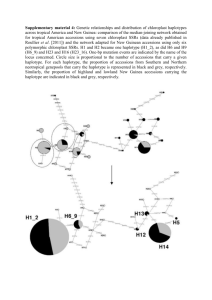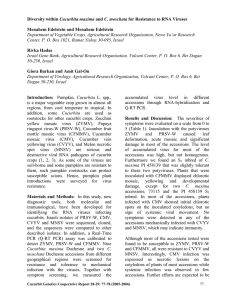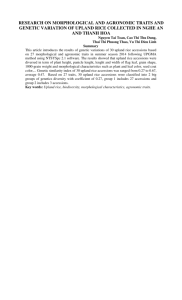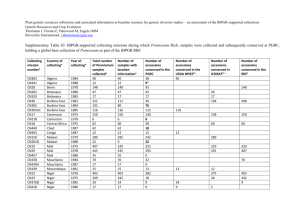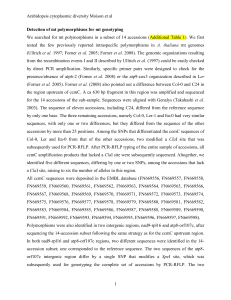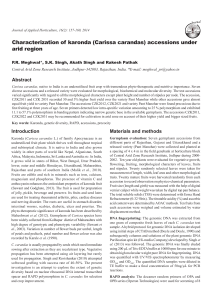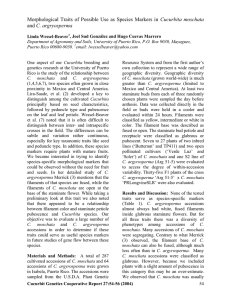Cucurbita maxima
advertisement
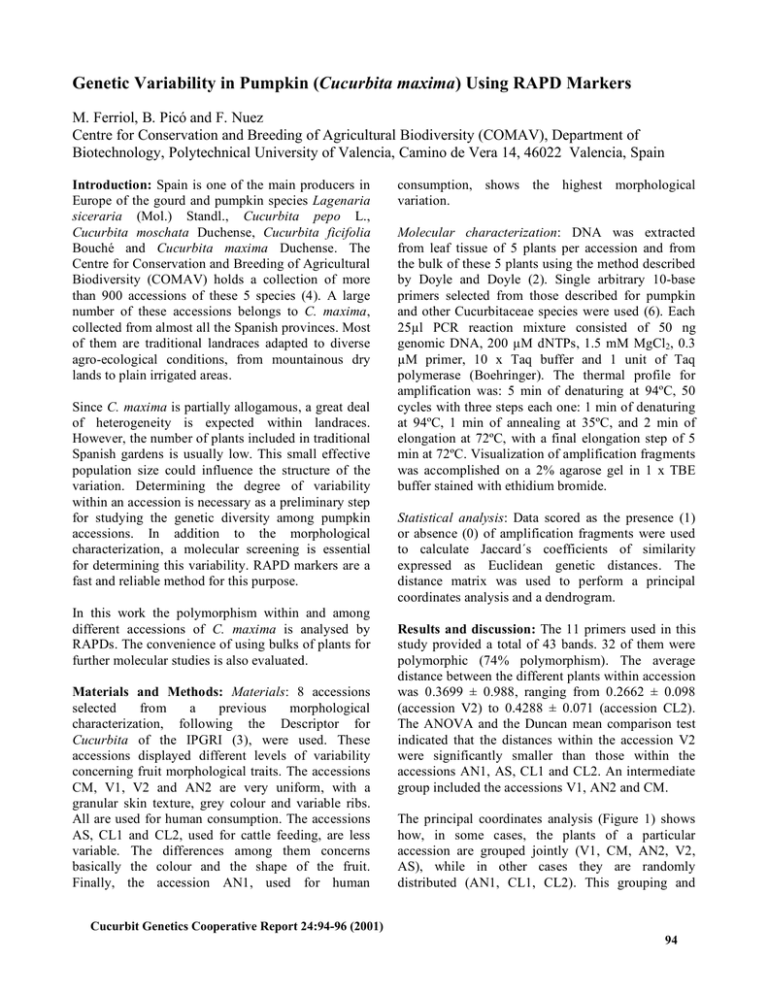
Genetic Variability in Pumpkin (Cucurbita maxima) Using RAPD Markers M. Ferriol, B. Picó and F. Nuez Centre for Conservation and Breeding of Agricultural Biodiversity (COMAV), Department of Biotechnology, Polytechnical University of Valencia, Camino de Vera 14, 46022 Valencia, Spain Introduction: Spain is one of the main producers in Europe of the gourd and pumpkin species Lagenaria siceraria (Mol.) Standl., Cucurbita pepo L., Cucurbita moschata Duchense, Cucurbita ficifolia Bouché and Cucurbita maxima Duchense. The Centre for Conservation and Breeding of Agricultural Biodiversity (COMAV) holds a collection of more than 900 accessions of these 5 species (4). A large number of these accessions belongs to C. maxima, collected from almost all the Spanish provinces. Most of them are traditional landraces adapted to diverse agro-ecological conditions, from mountainous dry lands to plain irrigated areas. Since C. maxima is partially allogamous, a great deal of heterogeneity is expected within landraces. However, the number of plants included in traditional Spanish gardens is usually low. This small effective population size could influence the structure of the variation. Determining the degree of variability within an accession is necessary as a preliminary step for studying the genetic diversity among pumpkin accessions. In addition to the morphological characterization, a molecular screening is essential for determining this variability. RAPD markers are a fast and reliable method for this purpose. In this work the polymorphism within and among different accessions of C. maxima is analysed by RAPDs. The convenience of using bulks of plants for further molecular studies is also evaluated. Materials and Methods: Materials: 8 accessions selected from a previous morphological characterization, following the Descriptor for Cucurbita of the IPGRI (3), were used. These accessions displayed different levels of variability concerning fruit morphological traits. The accessions CM, V1, V2 and AN2 are very uniform, with a granular skin texture, grey colour and variable ribs. All are used for human consumption. The accessions AS, CL1 and CL2, used for cattle feeding, are less variable. The differences among them concerns basically the colour and the shape of the fruit. Finally, the accession AN1, used for human Cucurbit Genetics Cooperative Report 24:94-96 (2001) consumption, shows the highest morphological variation. Molecular characterization: DNA was extracted from leaf tissue of 5 plants per accession and from the bulk of these 5 plants using the method described by Doyle and Doyle (2). Single arbitrary 10-base primers selected from those described for pumpkin and other Cucurbitaceae species were used (6). Each 25µl PCR reaction mixture consisted of 50 ng genomic DNA, 200 µM dNTPs, 1.5 mM MgCl2, 0.3 µM primer, 10 x Taq buffer and 1 unit of Taq polymerase (Boehringer). The thermal profile for amplification was: 5 min of denaturing at 94ºC, 50 cycles with three steps each one: 1 min of denaturing at 94ºC, 1 min of annealing at 35ºC, and 2 min of elongation at 72ºC, with a final elongation step of 5 min at 72ºC. Visualization of amplification fragments was accomplished on a 2% agarose gel in 1 x TBE buffer stained with ethidium bromide. Statistical analysis: Data scored as the presence (1) or absence (0) of amplification fragments were used to calculate Jaccard´s coefficients of similarity expressed as Euclidean genetic distances. The distance matrix was used to perform a principal coordinates analysis and a dendrogram. Results and discussion: The 11 primers used in this study provided a total of 43 bands. 32 of them were polymorphic (74% polymorphism). The average distance between the different plants within accession was 0.3699 ± 0.988, ranging from 0.2662 ± 0.098 (accession V2) to 0.4288 ± 0.071 (accession CL2). The ANOVA and the Duncan mean comparison test indicated that the distances within the accession V2 were significantly smaller than those within the accessions AN1, AS, CL1 and CL2. An intermediate group included the accessions V1, AN2 and CM. The principal coordinates analysis (Figure 1) shows how, in some cases, the plants of a particular accession are grouped jointly (V1, CM, AN2, V2, AS), while in other cases they are randomly distributed (AN1, CL1, CL2). This grouping and 94 A A A C A A C D F F F H G F F G G H H G E H G D C C EC E E H B D BE D D BB B a A: CM, B: V1, C: V2, D: AN1, E: CL2, F: AN2, G: AS, H: CL1. CMB b CM-CU-33B c V1B V-CU-1B V2B ASB V-CU-148B AN1B AS-CU-11B CL2B CL1B AN-CU-5B AN2B CL-CU-7B CL-CU-1B AN-CU-20B 0.00 0.00 0.14 0.14 0.27 0.27 Coefficient 0.41 0.41 0.54 0.54 Coefficient Figure 1. Variability within accessions in C. maxima (a): Principal coordinates analysis including 5 plants per accession, (b): Clustering of accessions using distances from bulking analysis, (c): Polymorphism within and among accessions using RAPDs. Each accession is represented by 5 plants and a bulk of these 5 plants. Cucurbit Genetics Cooperative Report 24:94-96 (2001) 95 those obtained by the ANOVA and the morphological characterization show a clear correspondence. The heterogeneity of the analysed landraces involves a great genetic richness and increases the possibility of selection within them. However, this variability makes the analysis of the molecular diversity among accessions more difficult. For this type of study, the analysis of a great number of individuals per accession is the more accurate method, since even the alleles with low frequency in the population would be represented. However, it is very expensive and tedious for routine studies. The use of bulks of leaf tissue or DNA of several plants per accession could be more suitable, although it is less informative since only the most frequent alleles of the population are represented. In this study, the average distance between accessions using bulks was 0.4328 ± 0.078, greater than that obtained within accessions. The dendrogram constructed from the bulks revealed three clusters that corresponded partially with the grouping based on fruit morphological characters (Figure 1). The usefulness of bulks for studying the variability among accessions is confirmed by the high correlation obtained between the distances among accessions calculated using bulks and those calculated using individual plants (r = 0.732; P = 0.002). Bulk analysis has also been reported in other allogamous species, such as Brassica oleracea L. (1) and Lolium perenne L. (5). Cucurbit Genetics Cooperative Report 24:94-96 (2001) Literature cited 1. Divaret, I., E. Margalé and G. Thomas, 1999. RAPD markers on seed bulks efficiently assess the genetic diversity of a Brassica oleracea L. collection. Theoretical and Applied Genetics 98: 1029-1035. 2. Doyle, J.J., and J.L. Doyle, 1990. Isolation of plant DNA from fresh tissue. In: FOCUS 12: 1315. 3. Esquinas-Alcázar, J.T. and P.J. Gulick, 1983. Genetic resources of Cucurbitaceae: a global report. IBPGR Secretariat, Roma, 101 pp. 4. Nuez, F., P. Fernández de Córdova, M. Ferriol, J.V. Valcárcel, B. Picó and M.J. Díez, 2000. Cucurbita spp. and Lagenaria siceraria collection of the genebank of the center for conservation and breeding of the agricultural biodiversity (COMAV) of the Polytechnical University of Valencia. Cucurbit Genetics Cooperative Report 23: 60-61. 5. Sweeney, P.M. and T.K. Danneberger, 1997. RAPD markers from perennial ryegrass DNA extracted from seeds. Hortscience 32 (7): 12121215. 6. Youn, S.J. and H.D. Chung, 1998. Genetic relationship among the local varieties of the Korean native squashes (Cucurbita moschata) using RAPD technique. Journal of the Korean Society for Horticultural Science 35 (5): 429437. 96
